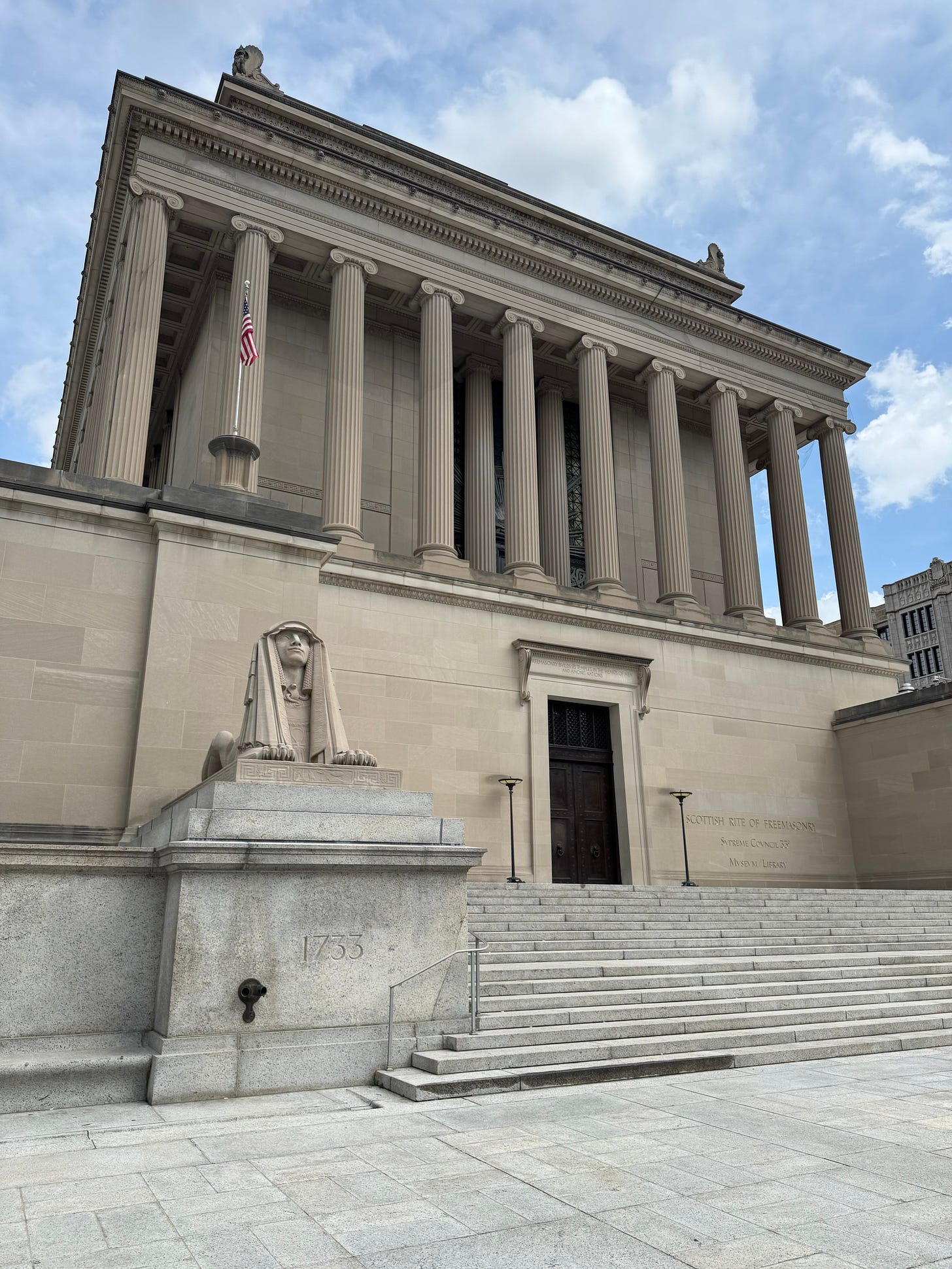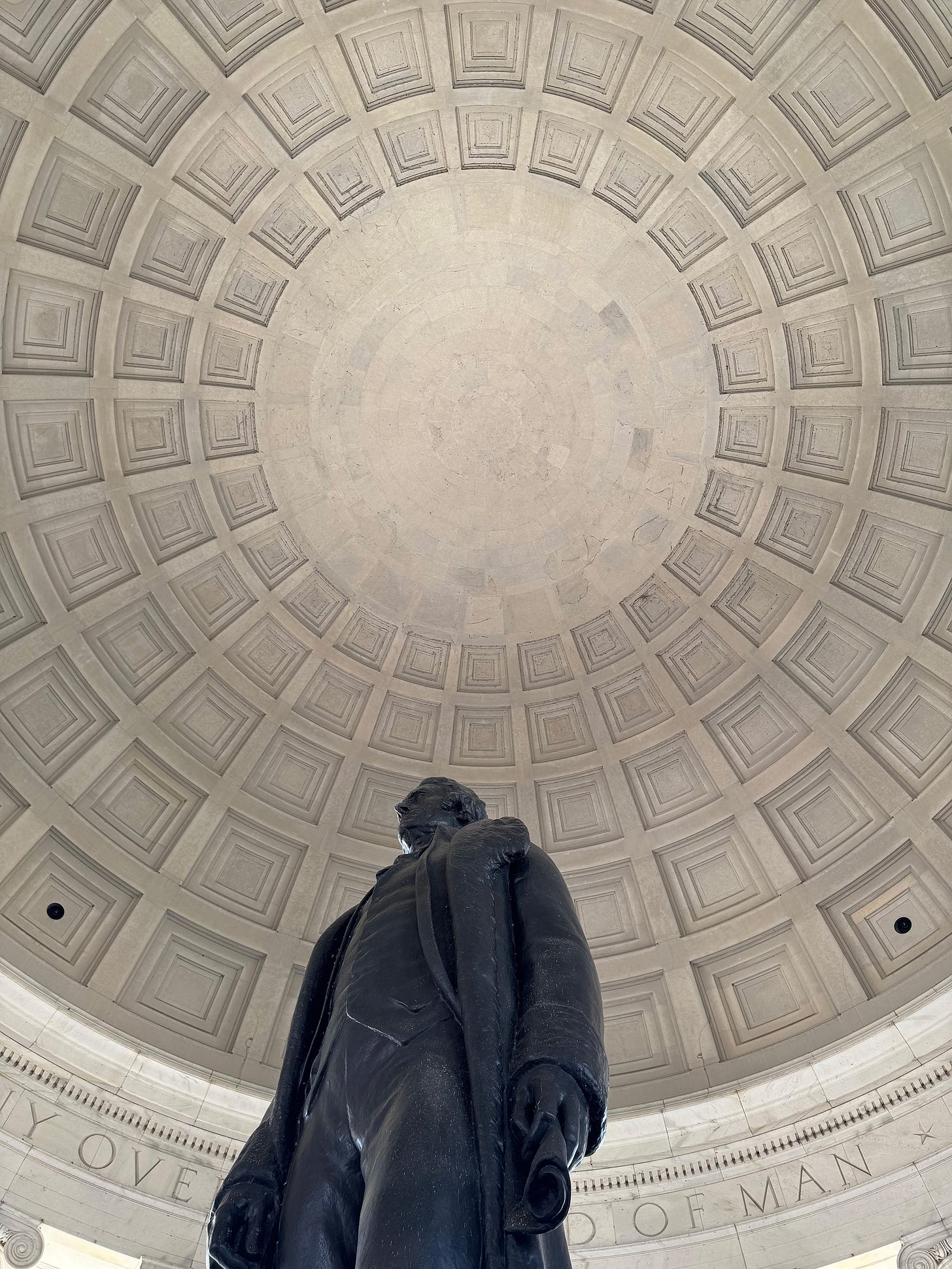To Build the Temple
Some ideas should last a thousand years. Let them come and be reminded of the wisdom of solidarity in a compact.
Look on my Works, ye Mighty, and despair!
Nothing beside remains. Round the decay
Of that colossal Wreck, boundless and bare
The lone and level sands stretch far away.”
—Percy Bysshe Shelly, from “Ozymandias”
I will die having written several books and thousands of articles, but I’m under no illusions. These clusters of symbols will be washed away by time. Even the intellectual and literary immortals will almost certainly be lost to the heat death of the universe—or to civilization’s predators, parasites, and iconoclasts.
Still, some of us crave a measure of immortality. We hope our children and our children’s children, at least, will turn their thoughts to us, even as the echoes of our living voices fade and all that’s left are albums of dusty photos or the words we’ve written. Was it Steve Jobs who said he wanted to put a dent in the universe?
Having just visited Washington, DC with my young son, I saw some inspiring examples of architecture meant to memorialize and inspire. We toured the Jefferson Memorial, featuring its neoclassical dome, columns, and inscriptions of the Declaration’s revolutionary words, which continue to draw throngs from around the world.
We even got to see the Scottish Rite Temple and Museum of the Freemasons, whose doors are flanked by sphinxes.
In that spirit, Dear Reader, I would like to share a dream with you. It’s an odd and anachronistic sort of dream.
Before I die, I want to see a temple built. Notwithstanding the above, it would not be a temple to me or mine. Instead, it would be a temple to a set of ideas—of patterns around which humans ought to organize if they seek peace, freedom, and abundance. Its truth will not fall like manna from above. It will be guidance from posterity, and its truth will have to be animated by good people.
Even if a godlike race of aliens were to visit Earth a few thousand years from now, perhaps after we have destroyed ourselves, the temple and its messages would weather the droughts, storms, and upheavals. It may be necessary to transcribe its inscribed prose into pictograms, serving as a sort of onsite Rosetta Stone.
Now, let us explore just what sort of principles should be represented. The first, the moral commitment, should be the prime directive, originating in the heart, projecting through the people’s voices in unison.
1. The Prime Directive
The first principle—the prime directive—should be visible to all upon entry in such a way that visitors to the temple know where to begin.
As we seek fulfillment, peace, and abundance, we will abstain from initiating harm, join others who share this commitment, and with them lock arms in solidarity.
We can define harm as making others worse off, whether by threat of violence, theft, or physical constraint. Some readers will find this familiar. Others will find it as absurd as King George III must have found the colonists’ Declaration.
2. The Law of Consent
To form the society of a people, the Prime Directive shall be expressed as law forged in agreement. Such an agreement is neither hypothetical nor tacit. It is, instead, a membership corpus one must join in order to enjoy its blessings.
All relationships between people must be consensual. Enforceable laws are established to serve a people, and their legitimacy arises from explicit consent, as expressed in a single multilateral contract based on these laws.
Such a commitment stands in contrast to theories of rights, freedoms, or legal protections derived from faith or fiction, rather than from solidarity in enforcement.
3. The Law of Justice
If humanity is to build a society based on relationships of consent, the society must instantiate a competitive system for the application of justice.
Whereas monopolies on the initiation of force create corrupting incentives and a dangerous tendency towards the accretion of absolute power, adults shall be free to contract with a protection, enforcement, or justice organization of their choosing—though all must be bound by commitment to the principles herein.
While eliminating force monopolies to create competition among organizations that protect their clients, steward enforcement, settle conflicts, and right wrongs might seem like a radical move, it is no more radical than choosing one’s food provider.
4. The Law of Exit
Taking more from that venerable text, we shall continue to roll upon the august wheel left to us by the Founders.
When any protection or enforcement organization fails to fulfill its purpose as a steward of the law, breaches its agreements, or the agreement expires, the people claim the right to exit its corpus or reject its stewards outright.
Solidarity around the right of one to exit any governance organization after a breach or expiration of the contracting period is designed to be an explicitly peaceful way to exercise “the Right of the People to alter or to abolish it, and to institute new Government”.
5. The Law of Association
We know that people have different moral and social sensibilities. So, rather than having a single, centralized authority seek to impose a monolithic system on the whole of society, the law lets a thousand security and welfare organizations bloom.
Any signatory, having become a member of its corpus and willing to pledge to these principles in solidarity, may form or contract with a peaceful subsidiary association or mutual aid organization that enhances his or her security or welfare. No subsidiary association or organization shall violate these laws without consequences.
We cannot assume away hostility to the principles, the corpus, and members.
6. The Law of the Membrane
Invariably, some people will express an intention to violate these laws or succeed in violating the laws. Any society formed in solidarity around the good, both individual and collective, must form a protective membrane. And if a powerful faction within the corpus arises that openly threatens the corpus or violates its laws, perhaps to establish a monopoly state, secession is both a right and a duty.
Members may refuse membership to those whose past behavior indicates likely non-compliance with this compact. Members who grossly violate the compact (or threaten to) may be expelled following a fair review process. If a powerful faction threatens to overturn this compact, any subset of members may secede to form a new entity to preserve it.
Bear in mind that the world runs on persuasion and coercion (otherwise inaction). To etch the above foundations in granite or stone—to build the temple—is to remind people that peaceful persuasion is the moral means when interacting with other innocent people.
Otherwise, any system must meet power with counterpower.
No means are perfect, but if we can bestow upon posterity the rudiments of peaceful self-organization, that might be the greatest gift we can offer future generations.
7. The Law of Defence
While our highest aspiration is to live in peace and persuade others by reason, we must not shrink from the hard truth: some will resort to coercion or conquest. When persuasion fails and violence is imposed upon the innocent, the only just response is to meet unjust power with just counterpower.
Signatories retain the right to defend life, liberty, and property against unlawful force. In keeping with our prohibition of coercive monopolies, no single military force shall dominate. Instead, members may contract with or form voluntary defense associations. These organizations must be bound by the compact, and may coordinate for mutual defense, so long as they do not themselves become instruments of tyranny.
Defensive force is justified only when used in proportion, aimed at the restoration of peace, and answerable to the corpus of members through transparent review. The permanence of peace depends on the discipline of those entrusted with its defense.
The foregoing might not be exhaustive to express the necessary primitives of a real concent compact symbolized in stone, but it is a beginning.
Imagine the Temple
One can imagine the Prime Directive displayed in a distinct or central location, with the other Six Laws arrayed at the periphery, perhaps forming a circle or hexagon. Perhaps there could be a way to integrate the Six Social Virtues and Six Personal Virtues, too, with no intention of marking any beasts. One can also imagine a grand sanctuary flanked by exterior meeting rooms. But we should leave most to the imagination of architects inspired by the vision.
Imagining the temple’s form and aesthetic is one thing. Imagining how to fund, site and build the temple is quite another.
Overview
Legal Foundation: Establish DAO legal structure, tax status, and regulatory compliance with professional counsel
Token Economics: Create governance token with staking mechanism, quadratic voting, and automated fund redistribution
Smart Contracts: Deploy governance, treasury, staking, and contest management contracts with security audits
Site Selection Contest: Community-driven location competition with detailed feasibility requirements and transparent voting
Architectural Competition: Professional design contest with architects, IP clarity, and milestone-based development
Implementation Team: Select project manager, legal coordinator, financial controller, and community liaison through a reasonable process
Professional Services: Procure real estate, legal, and construction services through competitive bidding with community oversight
Governance Protocols: Establish proposal systems, voting thresholds, transparency requirements, and dispute resolution
Risk Management: Implement insurance coverage, contingency planning, and defined exit strategies
Operations Planning: Create transition from construction to temple management with sustainable funding models
We’ll leave timelines, success factors, and details for another day.
Alternatively, one could just form a small team to run the contests and carry out the project—or ask Elon Musk and/or other financiers for financial and organizational help.
I guess the real question is whether anyone can see the value in building something like this for posterity, instead of personal prosperity. And of course, if there’s a way to build it for both, that would be grand.
Tell me what you think about such a zany idea in the comments.
Reach out personally if you are inspired to do so.







I like this. Especially the Law of Consent and to be able to Exit if it's not fulfilling its stated principles. I think society would be so different if people agreed to be a part of it. I've always found it strange that it is assumed that we all agreed to this. I never did, nobody EVER came to me and said, "Do you consent to all of this?" How would it be different if we all consented to this?
Why limit to “licensed architects”?
All the great buildings you reference were done without government licenses.